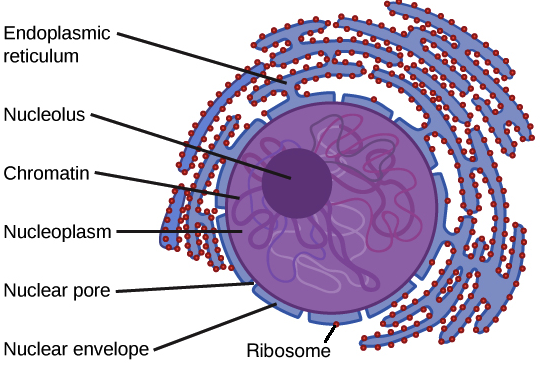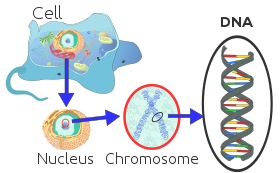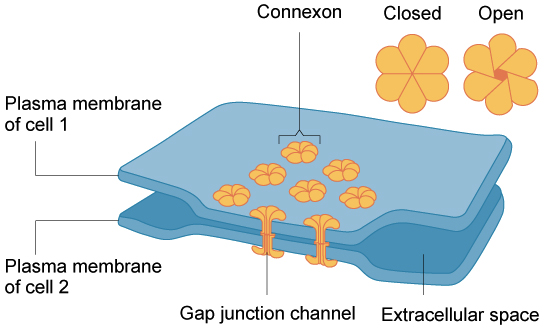Cell theory
- all living things are composed of one or more cells
- the cell is the basic unit of life
- new cells arise from pre-existing cells
Prokaryotic and Eukaryotic cells
- 4 key components of cell: plasma membrane, cytoplasm, DNA, ribosomes
- prokaryotic cells are one single open space(without membrane walls inside)
- prokaryotic DNA is in nucleoid
- the surface-area-to-volume ratio(exchange capacity of the cell) regulates cell size
Eukaryotic cells
- membrane bound nucleus
- a number of membrane-bound organelles
- multiple linear chromosomes
Plasma membrane and cytoplasm
- plasma membrane: a double layer consists of phospholipids, divides in&out of the cell
- its two-layer structure called a phospholipid bilayer
- cytoplasm: everything found inside the plasma membrane(in prokaryotes), between the plasma membrane and the nuclear envelope(nucleus)(in eukaryotes)
- cytosol=goo
Nucleus and ribosomes
- nuclear envelope: made up of two layers of membrane
- in the space between the two layers: endoplasmic reticulum
- nucleolus: new ribosomes are assembled(by ribosomal RNA)
- in prokaryotes DNA is organized into a loop structure chromosome
- in eukaryotes DNA is organized into a string structure chromosome
- endoplasmic reticulum: rough one(with ribosomes)/ smooth one(without ribosomes)
The endomembrane system
- a group of membranes and organelles in eukaryotic cells
- nuclear envelope/ lysosomes/ endoplasmic reticulum/ Golgi apparatus and the plasma membrane
The endoplasmic reticulum
- the rough endoplasmic reticulum(rough ER): ribosomes(attached to its cytoplasmic surface) make proteins>packaged into vesicles>shipped to the Golgi apparatus
- the smooth endoplasmic reticulum(smooth ER): no ribosomes. synthesis of carbohydrate/lipids/steroid hormones, detoxification, storage(of calcium ions)
The Golgi apparatus
- cis face(the receiving side)>modify proteins and lipids>tagged and sorted, packaged into vesicles(again)>trans face(exit)>bud from the Golgi
- lysosomes: an organelle contains digestive enzymes(in plants cells, called vacuole)
- phagocytosis(process): pathogen(like a virus) engulfed by macrophages(white blood cell)>a phagosome contain pathogen>lysosome involve, destroy the pathogen
Mitochondria and chloroplasts
- Mitochondria act as the powerhouse of the cell, through cellular respiration
- Chloroplasts act the same for plants and algae, through photosynthesis
- photosynthesis
- thylakoid: contains light-harvesting complexes that include chlorophyll
- Mitochondria make adenosine triphosphate(ATP)
- ATP making process=cellular respiration
The cytoskeleton
- 3 types of protein fibers in the cytoskeleton(in eukaryotes)
- microfilaments: the narrowest, made of actin, highways inside the cell
- intermediate filaments: specialized to bear tension, maintain the shape of the cell
- microtubules: help the cell resist compression forces
- microtubules are components of eukaryotic cell structure: flagella, cilia, centrosomes
- flagella: like a moving tale of a sperm
- cilia: like a short hair in nostrils(nose holes)
- both have 9+2 array
- centrosomes consists of 2 centrioles(=modified basal body)
- centrosomes: microtubule organizing center, its exact function is at open research
Extracellular structures and cell-cell junctions
- extracellular matrix(ECM): a complex meshwork of proteins and carbohydrates, a major component is the protein collagen
- proteoglycan complex: interwoven with collagen fibers
- integrins: embedded in the plasma membrane. anchor the cell, sense its environment(ex. blood clotting)
- fibronectin: act as bridges between integrins and other ECM proteins(collagen)
- cell wall: plant's supportive extracellular structure(collagen for animals), a major organic molacule is cellulose
Cell-cell junctions
- plasmodesmata: have a hole to allow direct cytoplasmic exchange between two cells
- gap junctions: channels between neighboring cells, 6 connexins=a connexon
- tight junctions: create a watertight seal between two adjacent animal cells(ex. our bladder)
- claudins: tight junction proteins
- desmosomes: junctions of animal cell. pin adjacent cells together, ensuring stretching skin or muscle remain connected in an unbroken sheet
- cadherins: adhesion(sticking) proteins, hold the membranes together









No comments:
Post a Comment